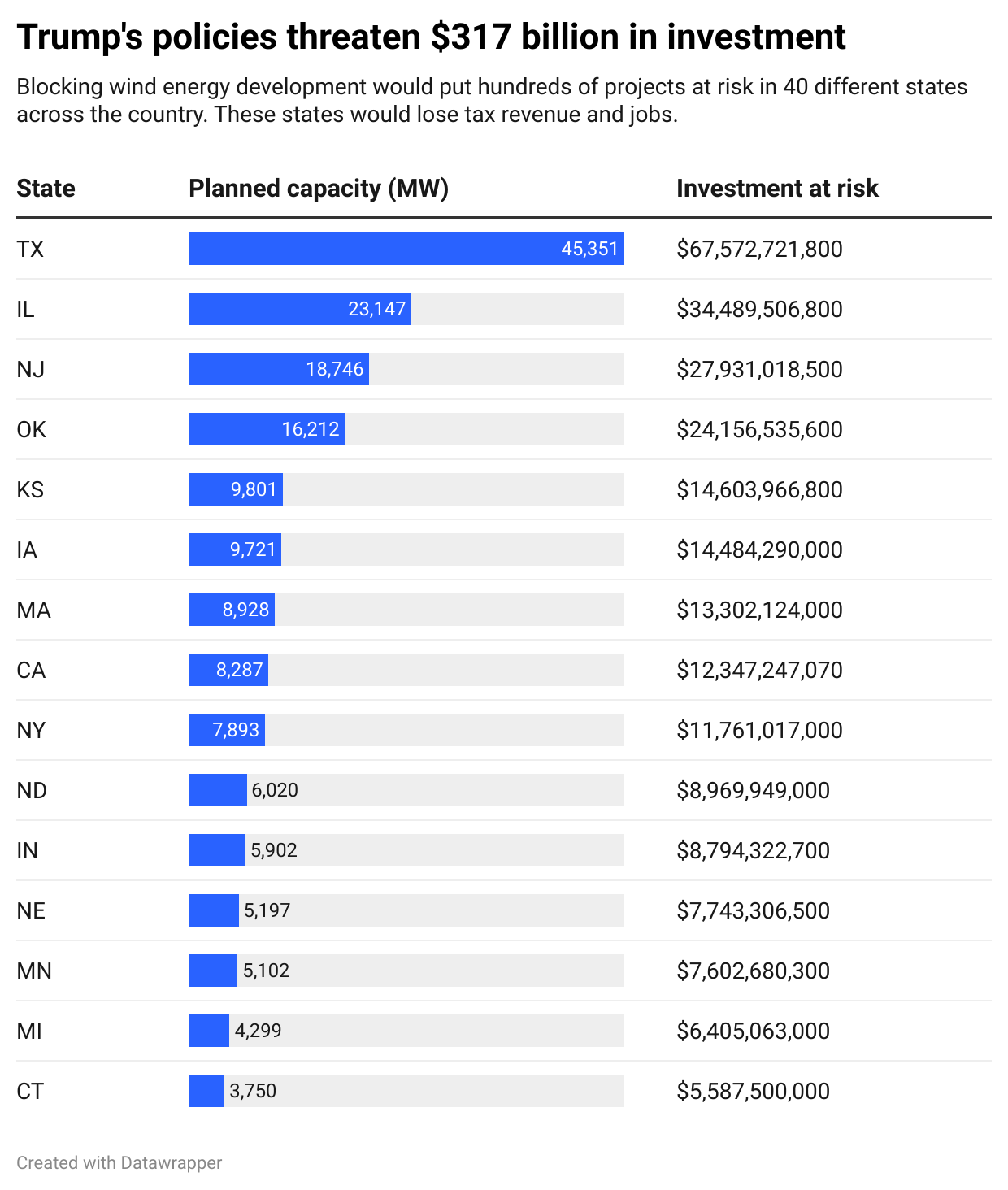Trump's Latest Policy Could Threaten Every Wind Project in America
The extreme policy could cost the US $317 billion in lost investment
President Trump has been a vocal opponent of wind energy for more than a decade. But up until recently, his policies have never matched his rhetoric.
The first Trump administration did little to slow the growth of wind energy. The US installed 37 GW of wind capacity between when the President took office in 2017 and when he reluctantly left four years later—160% more capacity than the four years prior, according to Cleanview data.
Shortly before he took office in January, Trump told reporters in Mar-a-Lago that his second administration would take a very different approach to wind energy. “We are going to have a policy where no windmills are being built,” he said.
The growth of wind energy and the legal guardrails that should make such policy impossible made it easy to dismiss this early warning sign. Since then, it’s become clear that the administration is willing to break laws and pursue unprecedented policies to stop wind energy development entirely.
A new escalation that could threaten every wind project
This week, Heatmap’s Jael Holzman broke a story about the administration’s latest attack on wind energy:
The Transportation Department last Tuesday declared that it would now call for a national 1.2-mile property setback — that is, a mandatory distance requirement — for all wind facilities near railroads and highways.
A 1.2-mile setback in a country with as many highways and railroads as ours would restrict development on a huge swatch of the country’s land. But it was a single sentence buried in the same release that signaled a threat that could be much larger.
DOT said that it would instruct the Federal Aviation Administration to “thoroughly evaluate proposed wind turbines to ensure they do not pose a danger to aviation” — a signal that a once-routine FAA height clearance required for almost every wind turbine could now become a hurdle for the entire sector.
If the administration were to stop issuing FAA height clearance approvals, it would grind development to a halt for every wind energy project in America—on both federal and private land. By weaponizing this simple administrative procedure, the FAA could—at least temporarily—achieve Trump’s vision of “no windmills being built.”
Such a move would be challenged in courts. But even if a judge forces the administration to approve projects, damage would be done. With clean electricity tax credits set to expire by the end of 2027, FAA delays could threaten the financial viability of projects. That, and the larger policy uncertainty surrounding wind energy and the administration’s willingness to break the law, could scare off would-be investors making it impossible to fund a project.
Restrictive wind policies put $317 billion of investment at risk
Across the country, wind developers have planned 790 projects totaling 213 GW of power capacity, according to Cleanview’s project tracker. For now, virtually all of these projects face some kind of risk of cancellation or delay given the administration’s latest extreme policy position.
The cancellation of these projects could result in as much as $320 billion of lost investment.1 The impact of this lost investment would be felt across the country. But the damage would disproportionately impact Republican-led states like Texas, Oklahoma, Kansas, and Iowa.
Cancelled projects would also result in less tax revenue and land lease payments to farmers in counties that voted overwhelmingly for Trump. Last year, I found that 88% of wind projects were built in counties that voted for Trump in 2020.
The country would also lose a much needed source of new electricity generation if the Trump administration killed or delayed hundreds of wind projects.
Electricity demand is rising faster than it has in decades. States like Texas have proven that its possible to meet extraordinary load growth while increasing reliability, cutting emissions, and reducing prices by building renewables and storage.
The country as a whole could follow in the footsteps of Texas. But not if the Trump administration restricts the supply of new energy.
The Republican Senators that could force Trump’s hand
There are few people in the country that could sway the administration’s position on FAA approvals and other restrictive wind policies. A group of climate activists yelling in the street is going to do nothing but feed into Trump’s larger narrative of fighting “elite environmentalists.” But one small group could force the President’s hand—and has proven recently that they are willing to put real pressure on the administration.
Last week Sen. Chuck Grassley announced that he would place holds on three Treasury Department nominees over the administration’s plan to end solar and wind tax credits earlier than originally agreed to.
To win over Republicans like Grassley who wanted a slow phase out of clean energy tax credits, Trump's big tax bill was written to give renewable developers 12 months to get solar and wind tax credits under construction. Up until now, that means they just need to spend more than 5% of their project’s capital and make progress on the project for 4 years.
But Trump and far-right extremists in the party made a backroom deal. If the far-right voted for the bill, Trump promised to have his Treasury Department rewrite the rules on what "begin construction" means.
This betrayal upset the group of Republicans that fought for a slow phase out including:
Sen. John Curtis (UT)
Sen. Lisa Murkowski (Alaska)
Sen. Chuck Grassley (Iowa)
Sen. Joni Ernst (Iowa)
Sen. Jerry Moran (Kansas)
Shortly after Grassley announced he would hold up Treasury Department nominees, Politico reported that Sen. Curtis would join him.
The other Senators could join Grassley and Curtis and pressure the administration into making good on its promise to support “all-of-the-above” energy policy. The alternative is less investment in their communities, fewer jobs, and rising electricity costs.



